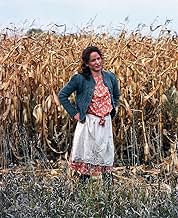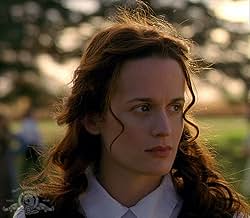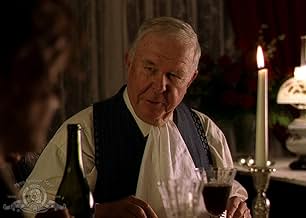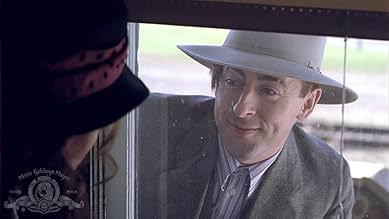VALUTAZIONE IMDb
7,1/10
4305
LA TUA VALUTAZIONE
Aggiungi una trama nella tua linguaIn 1920, Inge, a German national, travels from Norway to rural Minnesota for her arranged marriage to Olaf, a Norwegian farmer; bureaucracy and prejudice cause major complications.In 1920, Inge, a German national, travels from Norway to rural Minnesota for her arranged marriage to Olaf, a Norwegian farmer; bureaucracy and prejudice cause major complications.In 1920, Inge, a German national, travels from Norway to rural Minnesota for her arranged marriage to Olaf, a Norwegian farmer; bureaucracy and prejudice cause major complications.
- Premi
- 9 vittorie e 2 candidature totali
Recensioni in evidenza
As a total movie addict, I was very surprised after attending a screening of this film to be so overwhelmed by the quality of the photography and the depth of the acting.
The visual images in this film are simple, yet breathtakingly beautiful in their composition. It is a rare masterpiece with amazing use of time, depth and perspective. The development of the romantic tension between the main characters in the love story was so powerful and yet so subtle, that it was like a fresh breath mint on a cold January morning.
The used of time and flashbacks is amazing, and the editing and pace of the movie is very accomplished for an independent, low budget film. I will not be surprised if I hear about this move at Oscar time.
The visual images in this film are simple, yet breathtakingly beautiful in their composition. It is a rare masterpiece with amazing use of time, depth and perspective. The development of the romantic tension between the main characters in the love story was so powerful and yet so subtle, that it was like a fresh breath mint on a cold January morning.
The used of time and flashbacks is amazing, and the editing and pace of the movie is very accomplished for an independent, low budget film. I will not be surprised if I hear about this move at Oscar time.
Sadly, if something isn't blowing up or someone isn't sawing someone's limb off, too many people and kids have become numb to violence and need a more violent fix that never gets satisfied. This is a wonderful glimpse into the hard life of being an immigrant from a foreign land, just like today, but even harder. Great casting supported by wonderful cinematography, and yes...story line. Like many of our ancestors, yet we forget wanting to shut the door behind us and not accept and celebrate this wonderful world of variety. Please give it a chance and be patient and not expect a James Bond action thriller. See it with open eyes and context it was meant to be viewed in.
This is the story of a German mail order bride who moves to a small, Minnesota town filled with Norwegians who don't exactly embrace difference.
The movie creates a palatable tension between doing what you need to do to fit in with your community (what you're "supposed" to do) and finding love with someone who is different (what you should do).
That message resonates in today's political climate.
A funny, poignant, wonderfully acted movie, Sweet Land has the confidence to treat us as if we are intelligent. It lets us fill in the blanks and trusts us to understand what's going on without telling us everything. While this makes us work a little rather than sit back and be spoon fed the entertainment, the effort is well worth it.
For example, when characters speak German, instead of using subtitles, the filmmakers know we'll get the gist of the scene - even though we don't get the exact verbiage. Selim lets the emotion carry us and it works. This is delicate work but it's handled with care and talent.
Sweet Land is about how love is stronger than fear.
Very, very good movie...the kind they don't make in Hollywood. I'd compare it to Jean de Florette and the sequel Manon of the Spring. It's a simple story with complex emotions where the smallest details, like someone taking a huge bite of potatoes, say a lot.
Excellent movie.
The movie creates a palatable tension between doing what you need to do to fit in with your community (what you're "supposed" to do) and finding love with someone who is different (what you should do).
That message resonates in today's political climate.
A funny, poignant, wonderfully acted movie, Sweet Land has the confidence to treat us as if we are intelligent. It lets us fill in the blanks and trusts us to understand what's going on without telling us everything. While this makes us work a little rather than sit back and be spoon fed the entertainment, the effort is well worth it.
For example, when characters speak German, instead of using subtitles, the filmmakers know we'll get the gist of the scene - even though we don't get the exact verbiage. Selim lets the emotion carry us and it works. This is delicate work but it's handled with care and talent.
Sweet Land is about how love is stronger than fear.
Very, very good movie...the kind they don't make in Hollywood. I'd compare it to Jean de Florette and the sequel Manon of the Spring. It's a simple story with complex emotions where the smallest details, like someone taking a huge bite of potatoes, say a lot.
Excellent movie.
This film is most absorbing, but you have to be willing to watch a film that unfolds slowly. It is magnificently acted with two young actors -- Elizabeth Reaser and Tim Guinee as the leads. There is relatively little dialogue, and much of it is in German or Norwegian with no subtitles, which conveys to the audience the difficulty that they have communicating with each other.
The two leads are heavily dependent upon the expressiveness of their eyes, which they do with great delicacy. The film is well-paced and beautifully photographed. The only difficulty I had was catching on that the action took place in three time periods, not just two. You had 1920 when Inge, a mail order bride comes to rural Minnesota. (The scenery looked authentic, and since some of the credits are for institutions in Montevideo, MN, a town to which I once traveled, I can understand the veracity of the setting.)
The second time period, which is not so clear, is when Olaf, Inge's husband has passed away, and the third time period is more or less the present when Inge's grandson is faced with a decision of whether or not to sell the farm. There are some visual clues to separate the second and third time periods, but they are quite subtle.
The second is probably around 1960, marked by the glasses frames that Inge, as an old woman is wearing; and the third, by a jacket that her great-granddaughter is wearing. Otherwise, the time differences are not totally clear, particularly at the beginning of the film, where you have flashbacks.
The film struck me with its apparent accuracy. Twenty years ago, I knew an elderly Norwegian immigrant who had been the wife of a North Dakota farmer, and she had told me stories of farm life in the 1920s and 1930s. It required about 15 people to operate a steam threshing machine, and she told me about preparing lunch each day during the harvest season for 20 men; and about reading by candlelight at night; using an indoor pump at the sink; and seeking to keep warm during the brutal North Dakota winters.
I visited the woman and her daughters and grand-daughter in her modern apartment which was a far cry from life during her youth. It blows me away to think about the change in this one woman's singular life from her youth to her later years -- greater changes than in any prior period in history. (In 1946, there were still more horse drawn tractors than mechanized ones in use in the U.S., and there wasn't much electricity in rural areas until the New Deal.)
Although I may have missed some, I perceived no wrong notes in the film which added to the enjoyment of watching it. A most charming film from beginning to end.
The two leads are heavily dependent upon the expressiveness of their eyes, which they do with great delicacy. The film is well-paced and beautifully photographed. The only difficulty I had was catching on that the action took place in three time periods, not just two. You had 1920 when Inge, a mail order bride comes to rural Minnesota. (The scenery looked authentic, and since some of the credits are for institutions in Montevideo, MN, a town to which I once traveled, I can understand the veracity of the setting.)
The second time period, which is not so clear, is when Olaf, Inge's husband has passed away, and the third time period is more or less the present when Inge's grandson is faced with a decision of whether or not to sell the farm. There are some visual clues to separate the second and third time periods, but they are quite subtle.
The second is probably around 1960, marked by the glasses frames that Inge, as an old woman is wearing; and the third, by a jacket that her great-granddaughter is wearing. Otherwise, the time differences are not totally clear, particularly at the beginning of the film, where you have flashbacks.
The film struck me with its apparent accuracy. Twenty years ago, I knew an elderly Norwegian immigrant who had been the wife of a North Dakota farmer, and she had told me stories of farm life in the 1920s and 1930s. It required about 15 people to operate a steam threshing machine, and she told me about preparing lunch each day during the harvest season for 20 men; and about reading by candlelight at night; using an indoor pump at the sink; and seeking to keep warm during the brutal North Dakota winters.
I visited the woman and her daughters and grand-daughter in her modern apartment which was a far cry from life during her youth. It blows me away to think about the change in this one woman's singular life from her youth to her later years -- greater changes than in any prior period in history. (In 1946, there were still more horse drawn tractors than mechanized ones in use in the U.S., and there wasn't much electricity in rural areas until the New Deal.)
Although I may have missed some, I perceived no wrong notes in the film which added to the enjoyment of watching it. A most charming film from beginning to end.
This is a wonderful, artistically-shot film which, despite its sweet title, introduces a lot of subthemes about the underbelly of human nature. Presented to us as a flashback within a flashback, the story takes us back to the last century where socio/political/religious rules were hard to get around. But despite it being a period piece, we see powerful reflections of modern day.
Whether we're yelling "Witch!" or "German spy!" or "Pinko Communist!" or "Muslim Terrorist!", American society has always had a love affair with xenophobia that keeps frothing to the surface every few decades. What's interesting & inspiring about this movie is that it shows how individuals can still exist within this harsh, judgemental environment. Though society may be unfair & ignorant, we needn't get depressed & cynical about it. Romance can still exist.
In keeping with that theme, the story is very bright and light-hearted (though never sappy), and that's what I enjoyed most about it. The landscape is vibrant, and the director made full use of colour, unlike many period pieces that are shot in dull sepias. On the contrary, being a flashback, this film presents a somewhat dreamy, storybook image which is very nice on the eyes.
The star, Elizabeth Reaser, is so convincing as the European immigrant, and the way she unleashes rapid volleys of German and Swedish(?) is so authentic that I was certain she was a real-life German who couldn't speak any English. Imagine my surprise when I found out she's a Michigan girl. Her performance alone is worth the price of admission. If all mail-order-brides were like her, I'd be tempted to send away for a half dozen.
Whether we're yelling "Witch!" or "German spy!" or "Pinko Communist!" or "Muslim Terrorist!", American society has always had a love affair with xenophobia that keeps frothing to the surface every few decades. What's interesting & inspiring about this movie is that it shows how individuals can still exist within this harsh, judgemental environment. Though society may be unfair & ignorant, we needn't get depressed & cynical about it. Romance can still exist.
In keeping with that theme, the story is very bright and light-hearted (though never sappy), and that's what I enjoyed most about it. The landscape is vibrant, and the director made full use of colour, unlike many period pieces that are shot in dull sepias. On the contrary, being a flashback, this film presents a somewhat dreamy, storybook image which is very nice on the eyes.
The star, Elizabeth Reaser, is so convincing as the European immigrant, and the way she unleashes rapid volleys of German and Swedish(?) is so authentic that I was certain she was a real-life German who couldn't speak any English. Imagine my surprise when I found out she's a Michigan girl. Her performance alone is worth the price of admission. If all mail-order-brides were like her, I'd be tempted to send away for a half dozen.
Lo sapevi?
- QuizElizabeth Reaser' Norwegian pronunciation was so bad that after Dagbladet (one of Norway's biggest news-papers) stumbled upon this film, they posted a clip from it with the title "What is she trying to say?"
- BlooperThey harvest an entire field of corn between the two of them, when they get back to the barn, the crop is suddenly wheat. They go through the whole "separating the wheat from the chaff" process, and pour the seed into sacks.
- Citazioni
Old Inge: Olaf died, Frandsen.
Old Frandsen: [considering for a moment] No. Olaf is in the fields.
Old Inge: [slowly glancing out the window and remembering]
- Colonne sonoreEskimo Kisses
Music and Lyrics by Thomas Lieberman (as T.F. Lieberman)
Published by Liza Rose Music (ASCAP)
Performed by Thomas Lieberman (as Tom Lieberman)
I più visti
Accedi per valutare e creare un elenco di titoli salvati per ottenere consigli personalizzati
- How long is Sweet Land?Powered by Alexa
Dettagli
- Data di uscita
- Paese di origine
- Sito ufficiale
- Lingue
- Celebre anche come
- Wedding Photo
- Luoghi delle riprese
- Aziende produttrici
- Vedi altri crediti dell’azienda su IMDbPro
Botteghino
- Budget
- 1.000.000 USD (previsto)
- Lordo Stati Uniti e Canada
- 1.706.325 USD
- Fine settimana di apertura Stati Uniti e Canada
- 41.860 USD
- 15 ott 2006
- Lordo in tutto il mondo
- 1.843.537 USD
- Tempo di esecuzione1 ora 50 minuti
- Colore
- Mix di suoni
- Proporzioni
- 1.85 : 1
Contribuisci a questa pagina
Suggerisci una modifica o aggiungi i contenuti mancanti


































